Question Number 170601 by mr W last updated on 27/May/22
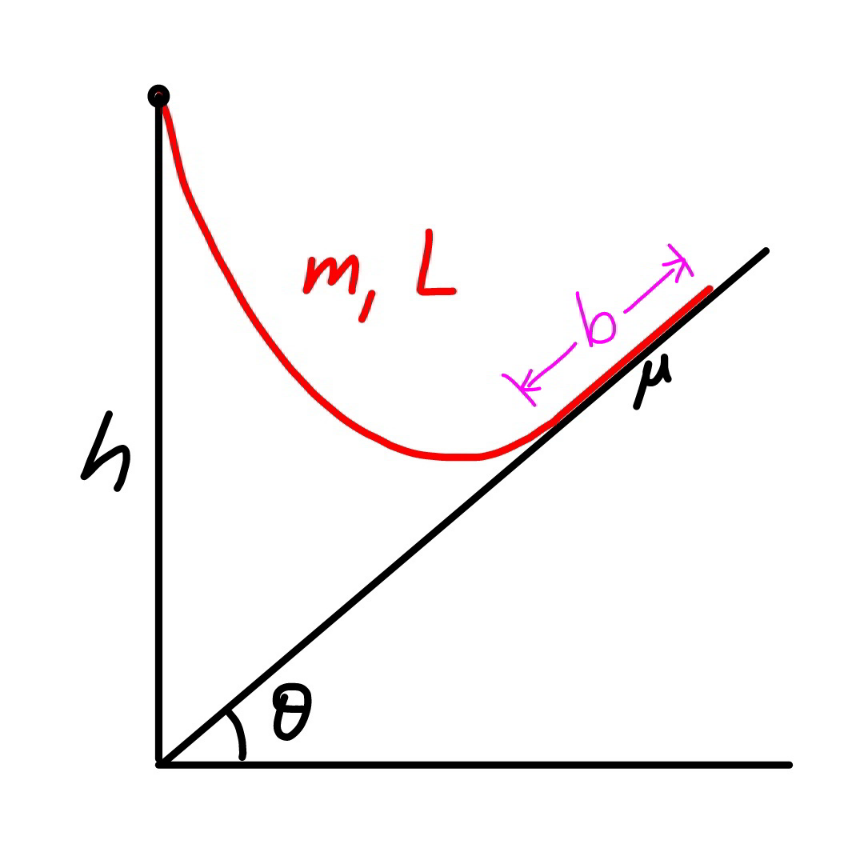
Commented by mr W last updated on 29/May/22
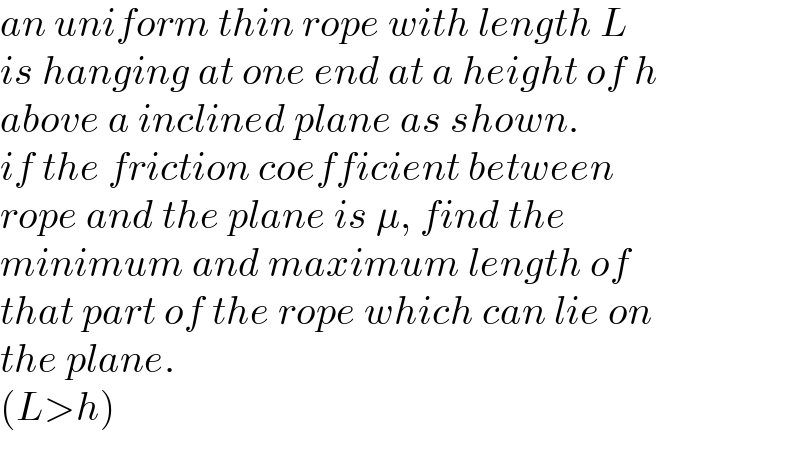
$${an}\:{uniform}\:{thin}\:{rope}\:{with}\:{length}\:{L} \\ $$$${is}\:{hanging}\:{at}\:{one}\:{end}\:{at}\:{a}\:{height}\:{of}\:{h}\: \\ $$$${above}\:{a}\:{inclined}\:{plane}\:{as}\:{shown}.\: \\ $$$${if}\:{the}\:{friction}\:{coefficient}\:{between}\: \\ $$$${rope}\:{and}\:{the}\:{plane}\:{is}\:\mu,\:{find}\:{the} \\ $$$${minimum}\:{and}\:{maximum}\:{length}\:{of}\: \\ $$$${that}\:{part}\:{of}\:{the}\:{rope}\:{which}\:{can}\:{lie}\:{on}\: \\ $$$${the}\:{plane}. \\ $$$$\left({L}>{h}\right) \\ $$
Answered by aleks041103 last updated on 28/May/22
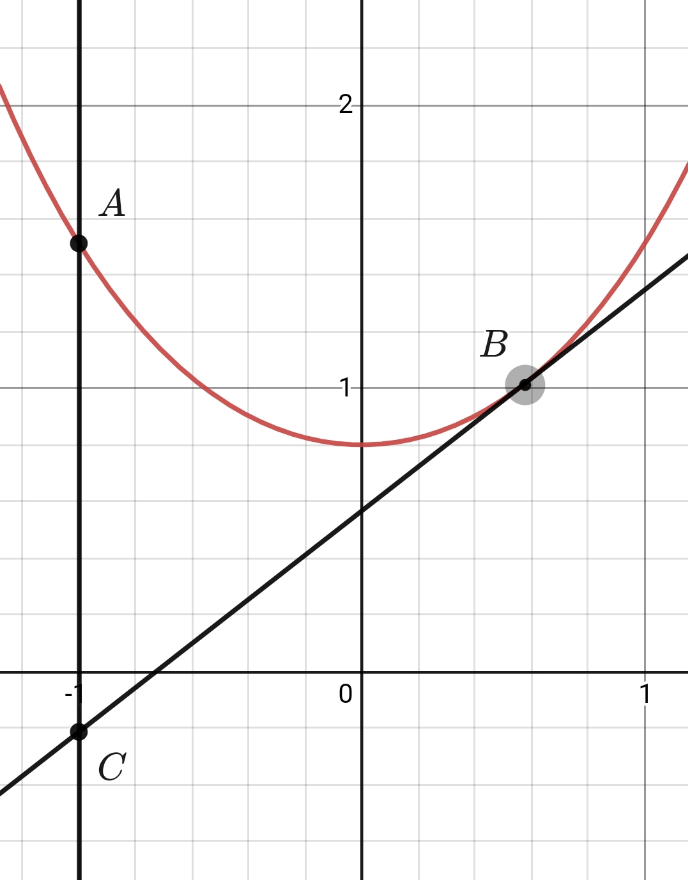
Commented by aleks041103 last updated on 28/May/22

$${red}\:{curve}\:\rightarrow\:{catenary} \\ $$$${y}={a}\:{cosh}\left(\frac{{x}}{{a}}\right) \\ $$$${length}\:{function}: \\ $$$$\int\sqrt{\mathrm{1}+{y}'^{\mathrm{2}} }{dx}=\int\sqrt{\mathrm{1}+{sinh}^{\mathrm{2}} \left(\frac{{x}}{{a}}\right)}{dx}= \\ $$$$=\int{cosh}\left(\frac{{x}}{{a}}\right){dx}={a}\:{sinh}\left(\frac{{x}}{{a}}\right) \\ $$$${Let}\:{length}\:{on}\:{slope}\:{be}\:{l},\:{then}\:{there}\:{is} \\ $$$${a}\:{rope}\:{of}\:{length}\:{L}−{l}\:{hanging}\:{or} \\ $$$${L}−{l}={a}\left({sinh}\left(\frac{{x}_{{b}} }{{a}}\right)−{sinh}\left(\frac{{x}_{{a}} }{{a}}\right)\right) \\ $$$${also} \\ $$$${y}'\left({x}_{{b}} \right)={tan}\theta={k} \\ $$$$\Rightarrow{sinh}\left(\frac{{x}_{{b}} }{{a}}\right)={k}\Rightarrow{x}_{{b}} ={a}\:{arcsinh}\left({k}\right) \\ $$$${and}\:{L}−{l}={a}\left({k}−{sinh}\left(\frac{{x}_{{a}} }{{a}}\right)\right) \\ $$$$\Rightarrow{slope}\:{has}\:{eqn}: \\ $$$${s}\left({x}\right)={k}\left({x}−{a}\:{arcsinh}\left({k}\right)\right)\:+\:{a}\sqrt{\mathrm{1}+{k}^{\mathrm{2}} } \\ $$$$\Rightarrow\:{for}\:{x}_{{a}} \:{we}\:{have} \\ $$$${acosh}\left(\frac{{x}_{{a}} }{{a}}\right)−{s}\left({x}_{{a}} \right)={h} \\ $$$$\Rightarrow{cosh}\left(\frac{{x}_{{a}} }{{a}}\right)−{k}\frac{{x}_{{a}} }{{a}}=\frac{{h}}{{a}}+\sqrt{\mathrm{1}+{k}^{\mathrm{2}} }−{k}\:{arcsinh}\left({k}\right) \\ $$$${Also},\:{the}\:{hanging}\:{part}\:{has}\:{two}\:{forces}\:{acting} \\ $$$${T}_{\mathrm{1}} \:{at}\:{A}\:{at}\:{angle}\:\alpha\:{to}\:{x}\:{and}\:{T}_{\mathrm{2}} \:{at}\:{B}\:{at}\:{angle} \\ $$$$\theta\:{to}\:{x}. \\ $$$${tan}\alpha={sinh}\left(\frac{{x}_{{a}} }{{a}}\right) \\ $$$$\Rightarrow{sin}\alpha=\frac{{tan}\alpha}{\:\sqrt{\mathrm{1}+{tan}^{\mathrm{2}} \alpha}}=\frac{{sinh}\left({x}_{{a}} /{a}\right)}{{cosh}\left({x}_{{a}} /{a}\right)}={tanh}\left(\frac{{x}_{{a}} }{{a}}\right) \\ $$$${cos}\alpha={sech}\left(\frac{{x}_{{a}} }{{a}}\right) \\ $$$$\Rightarrow{Equilibrium}\:{requires}: \\ $$$${T}_{\mathrm{1}} {cos}\alpha={T}_{\mathrm{2}} {cos}\theta \\ $$$$−{T}_{\mathrm{1}} {sin}\alpha+{T}_{\mathrm{2}} {sin}\theta=\frac{{L}−{l}}{{L}}{mg} \\ $$$${Also}\:{T}_{\mathrm{2}} \leqslant\frac{{l}}{{L}}\mu{mg}\:{cos}\theta \\ $$$$\Rightarrow{tg}\alpha\leqslant\frac{\frac{{l}}{{L}}\mu{mg}\:{sin}\theta{cos}\theta+\frac{{l}−{L}}{{L}}{mg}}{\frac{{l}}{{L}}\mu{mgcos}^{\mathrm{2}} \theta}= \\ $$$$={tg}\theta−\frac{{L}−{l}}{\mu{l}}{sec}^{\mathrm{2}} \theta=−\frac{{L}−{l}}{\mu{l}}\left(\mathrm{1}+{k}^{\mathrm{2}} \right)+{k}\geqslant{sinh}\frac{{x}_{{a}} }{{a}} \\ $$$$\Rightarrow{L}−{l}\leqslant{a}\left(\frac{{L}−{l}}{\mu{l}}\left(\mathrm{1}+{k}^{\mathrm{2}} \right)\right) \\ $$$$\Rightarrow{l}\leqslant\frac{{a}\left(\mathrm{1}+{k}^{\mathrm{2}} \right)}{\mu}\Rightarrow{a}\geqslant\frac{\mu{l}}{\mathrm{1}+{k}^{\mathrm{2}} } \\ $$$$… \\ $$$${A}\:{lot}\:{of}\:{inequalities}\:{left}\:{to}\:{do} \\ $$$$ \\ $$$$ \\ $$
Commented by mr W last updated on 29/May/22

$${thanks}\:{for}\:{the}\:{solution}\:{sir}! \\ $$
Answered by mr W last updated on 29/May/22
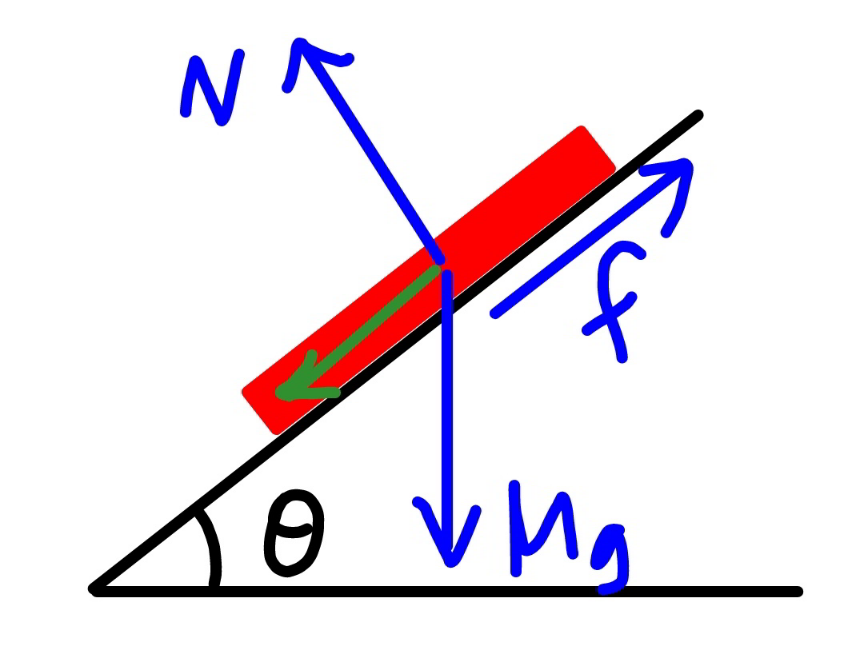
Commented by mr W last updated on 29/May/22
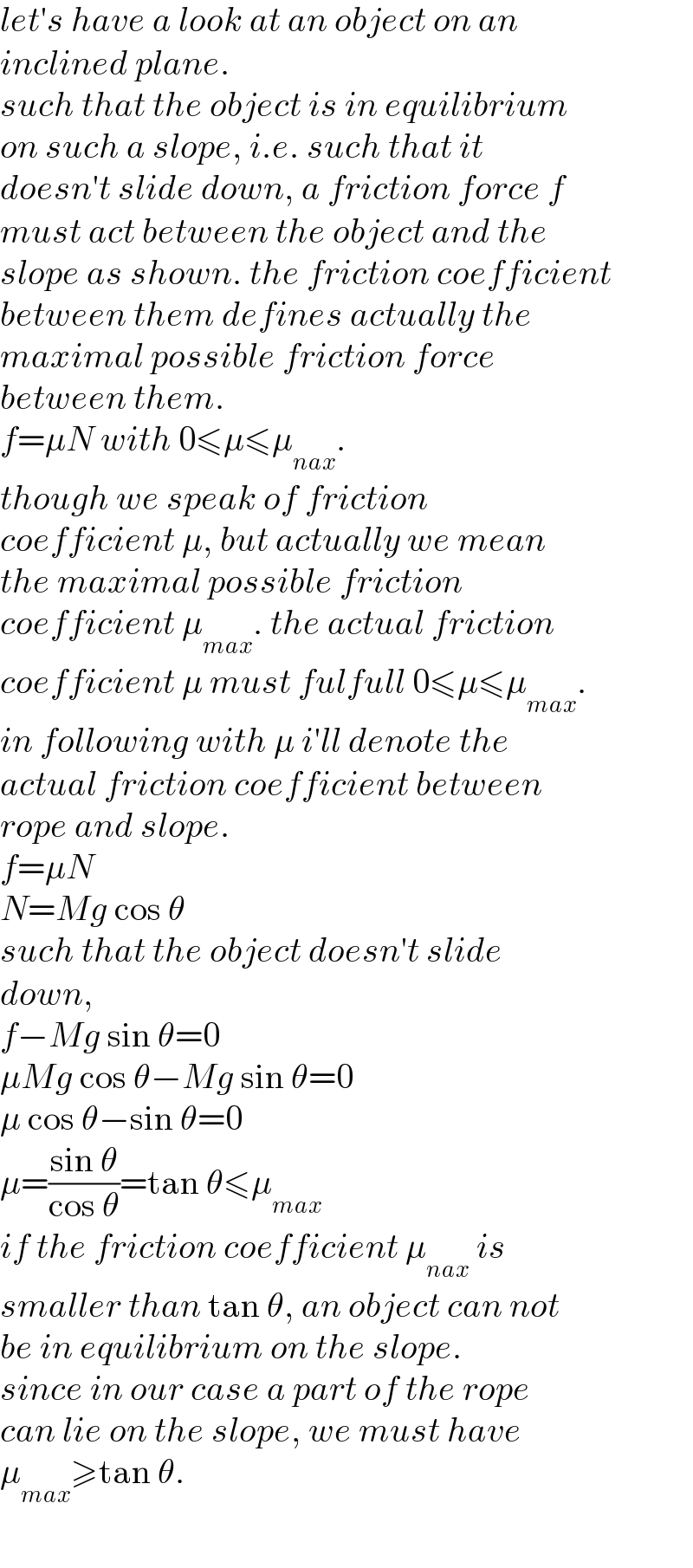
$${let}'{s}\:{have}\:{a}\:{look}\:{at}\:{an}\:{object}\:{on}\:{an} \\ $$$${inclined}\:{plane}. \\ $$$${such}\:{that}\:{the}\:{object}\:{is}\:{in}\:{equilibrium} \\ $$$${on}\:{such}\:{a}\:{slope},\:{i}.{e}.\:{such}\:{that}\:{it} \\ $$$${doesn}'{t}\:{slide}\:{down},\:{a}\:{friction}\:{force}\:{f} \\ $$$${must}\:{act}\:{between}\:{the}\:{object}\:{and}\:{the} \\ $$$${slope}\:{as}\:{shown}.\:{the}\:{friction}\:{coefficient} \\ $$$${between}\:{them}\:{defines}\:{actually}\:{the}\: \\ $$$${maximal}\:{possible}\:{friction}\:{force}\: \\ $$$${between}\:{them}. \\ $$$${f}=\mu{N}\:{with}\:\mathrm{0}\leqslant\mu\leqslant\mu_{{nax}} . \\ $$$${though}\:{we}\:{speak}\:{of}\:{friction} \\ $$$${coefficient}\:\mu,\:{but}\:{actually}\:{we}\:{mean} \\ $$$${the}\:{maximal}\:{possible}\:{friction} \\ $$$${coefficient}\:\mu_{{max}} .\:{the}\:{actual}\:{friction} \\ $$$${coefficient}\:\mu\:{must}\:{fulfull}\:\mathrm{0}\leqslant\mu\leqslant\mu_{{max}} . \\ $$$${in}\:{following}\:{with}\:\mu\:{i}'{ll}\:{denote}\:{the} \\ $$$${actual}\:{friction}\:{coefficient}\:{between} \\ $$$${rope}\:{and}\:{slope}. \\ $$$${f}=\mu{N} \\ $$$${N}={Mg}\:\mathrm{cos}\:\theta \\ $$$${such}\:{that}\:{the}\:{object}\:{doesn}'{t}\:{slide} \\ $$$${down},\: \\ $$$${f}−{Mg}\:\mathrm{sin}\:\theta=\mathrm{0} \\ $$$$\mu{Mg}\:\mathrm{cos}\:\theta−{Mg}\:\mathrm{sin}\:\theta=\mathrm{0} \\ $$$$\mu\:\mathrm{cos}\:\theta−\mathrm{sin}\:\theta=\mathrm{0} \\ $$$$\mu=\frac{\mathrm{sin}\:\theta}{\mathrm{cos}\:\theta}=\mathrm{tan}\:\theta\leqslant\mu_{{max}} \\ $$$${if}\:{the}\:{friction}\:{coefficient}\:\mu_{{nax}} \:{is} \\ $$$${smaller}\:{than}\:\mathrm{tan}\:\theta,\:{an}\:{object}\:{can}\:{not} \\ $$$${be}\:{in}\:{equilibrium}\:{on}\:{the}\:{slope}. \\ $$$${since}\:{in}\:{our}\:{case}\:{a}\:{part}\:{of}\:{the}\:{rope} \\ $$$${can}\:{lie}\:{on}\:{the}\:{slope},\:{we}\:{must}\:{have}\: \\ $$$$\mu_{{max}} \geqslant\mathrm{tan}\:\theta. \\ $$
Commented by mr W last updated on 29/May/22

Commented by mr W last updated on 29/May/22

$${case}\:\mathrm{1}:\:\mu=\mathrm{tan}\:\theta \\ $$$${we}\:{see}\:{the}\:{rope}\:{can}\:{take}\:{the}\:{shape} \\ $$$${as}\:{shown}\:{in}\:{diagram}.\:{the}\:{length}\:{of} \\ $$$${the}\:{part}\:{which}\:{lies}\:{on}\:{the}\:{slope}\:{is} \\ $$$${b}={L}−{h}. \\ $$
Commented by mr W last updated on 29/May/22
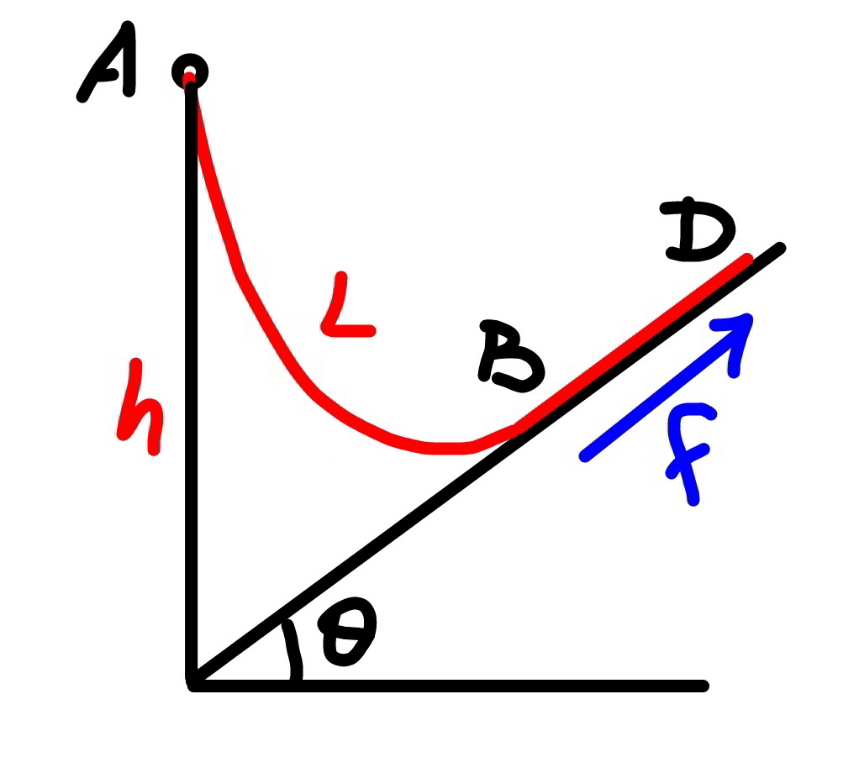
Commented by mr W last updated on 29/May/22

$${case}\:\mathrm{2}:\:\mu>\mathrm{tan}\:\theta \\ $$$${the}\:{friction}\:{force}\:{f}\:{is}\:{large}\:{enough} \\ $$$${so}\:{that}\:{it}\:{can}\:{even}\:{allow}\:{an} \\ $$$${addition}\:{tension}\:{force}\:{between}\:{the} \\ $$$${two}\:{parts}\:{of}\:{the}\:{rope}.\: \\ $$
Commented by mr W last updated on 29/May/22
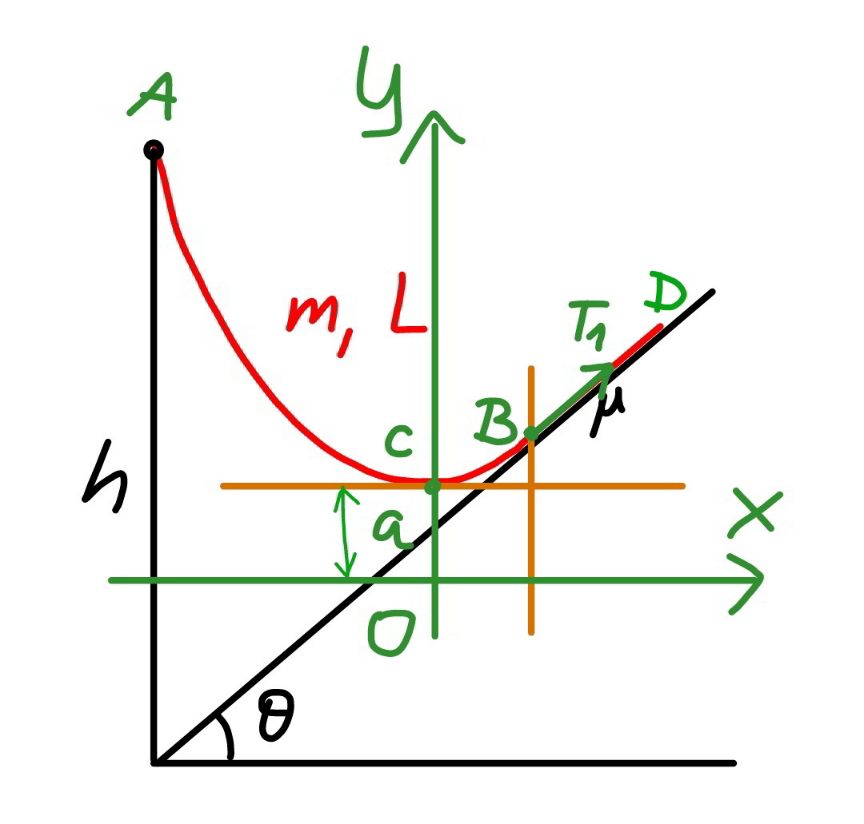
Commented by mr W last updated on 29/May/22
![say the length of the rope part which lies on the inclined plane is b. ρ=(m/L) the friction force between rope and the slope is f. f=μρgb cos θ with tan θ<μ≤μ_(max) tension in the rope at point B: T_1 =f−ρgb sin θ=(μ cos θ−sin θ)ρgb let μ′=μ cos θ−sin θ T_1 =μ′ρgb T_0 =T_1 cos θ=μ′ρgb cos θ define a=(T_0 /(ρg))=μ′b cos θ the hanging rope from point A to B is part of a catenary. w.r.t. the coordinate system as shown, y=a cosh (x/a) y′=sinh (x/a) s=a sinh (x/a) tan θ=sinh (x_B /a) ⇒(x_B /a)=sinh^(−1) (tan θ) s_1 =CB^(⌢) =a sinh (x_B /a)=a tan θ AC^(⌢) =L−b−s_1 =a sinh (x_A /a) L−b−a tan θ=a sinh (x_A /a) ⇒(x_A /a)=sinh^(−1) (((L−b)/a)−tan θ) y_A −y_B =h−(x_A +x_B ) tan θ a cosh (x_A /a)−a cosh (x_B /a)=h−(x_A +x_B ) tan θ cosh (x_A /a)−cosh (x_B /a)=(h/a)−((x_A /a)+(x_B /a)) tan θ cosh [sinh^(−1) (((L−b)/a)−tan θ)]−cosh [sinh^(−1) (tan θ)]=(h/a)−[sinh^(−1) (((L−b)/a)−tan θ)+sinh^(−1) (tan θ)] tan θ let (b/L)=(1/λ) cosh [sinh^(−1) (((λ−1)/(μ′ cos θ))−tan θ)]−cosh [sinh^(−1) (tan θ)]=((λh)/(μ′L cos θ))−[sinh^(−1) (((λ−1)/(μ′ cos θ))−tan θ)+sinh^(−1) (tan θ)] tan θ ⇒[sinh^(−1) (((𝛌−1)/(𝛍′ cos 𝛉))−tan 𝛉)+sinh^(−1) (tan 𝛉)]sin 𝛉=1+((𝛌h)/(𝛍′L))−(√(1+(((𝛌−1)/(𝛍′)))^2 −2(((𝛌−1)/(𝛍′))) sin 𝛉)) this equation shows the relationship between λ and the actual friction coefficient μ (tan θ<μ≤μ_(max) ). generally this relationship looks like as shown in the diagram below. example: h=3m, L=5m, θ=30°, μ_(max) =1.5 ⇒(b_(min) /L)=0.33202 at μ=1.5 ⇒(b_(max) /L)=0.43165 at μ=0.7](https://www.tinkutara.com/question/Q170693.png)
$${say}\:{the}\:{length}\:{of}\:{the}\:{rope}\:{part}\:{which} \\ $$$${lies}\:{on}\:{the}\:{inclined}\:{plane}\:{is}\:{b}. \\ $$$$\rho=\frac{{m}}{{L}} \\ $$$${the}\:{friction}\:{force}\:{between}\:{rope}\:{and} \\ $$$${the}\:{slope}\:{is}\:{f}. \\ $$$${f}=\mu\rho{gb}\:\mathrm{cos}\:\theta\:{with}\:\mathrm{tan}\:\theta<\mu\leqslant\mu_{{max}} \\ $$$${tension}\:{in}\:{the}\:{rope}\:{at}\:{point}\:{B}: \\ $$$${T}_{\mathrm{1}} ={f}−\rho{gb}\:\mathrm{sin}\:\theta=\left(\mu\:\mathrm{cos}\:\theta−\mathrm{sin}\:\theta\right)\rho{gb} \\ $$$${let}\:\mu'=\mu\:\mathrm{cos}\:\theta−\mathrm{sin}\:\theta \\ $$$${T}_{\mathrm{1}} =\mu'\rho{gb} \\ $$$${T}_{\mathrm{0}} ={T}_{\mathrm{1}} \:\mathrm{cos}\:\theta=\mu'\rho{gb}\:\mathrm{cos}\:\theta \\ $$$${define}\:{a}=\frac{{T}_{\mathrm{0}} }{\rho{g}}=\mu'{b}\:\mathrm{cos}\:\theta \\ $$$${the}\:{hanging}\:{rope}\:{from}\:{point}\:{A}\:{to}\:{B}\: \\ $$$${is}\:{part}\:{of}\:{a}\:{catenary}.\:{w}.{r}.{t}.\:{the} \\ $$$${coordinate}\:{system}\:{as}\:{shown}, \\ $$$${y}={a}\:\mathrm{cosh}\:\frac{{x}}{{a}} \\ $$$${y}'=\mathrm{sinh}\:\frac{{x}}{{a}} \\ $$$${s}={a}\:\mathrm{sinh}\:\frac{{x}}{{a}} \\ $$$$ \\ $$$$\mathrm{tan}\:\theta=\mathrm{sinh}\:\frac{{x}_{{B}} }{{a}}\:\Rightarrow\frac{{x}_{{B}} }{{a}}=\mathrm{sinh}^{−\mathrm{1}} \:\left(\mathrm{tan}\:\theta\right) \\ $$$${s}_{\mathrm{1}} =\overset{\frown} {{CB}}={a}\:\mathrm{sinh}\:\frac{{x}_{{B}} }{{a}}={a}\:\mathrm{tan}\:\theta \\ $$$$\overset{\frown} {{AC}}={L}−{b}−{s}_{\mathrm{1}} ={a}\:\mathrm{sinh}\:\frac{{x}_{{A}} }{{a}} \\ $$$${L}−{b}−{a}\:\mathrm{tan}\:\theta={a}\:\mathrm{sinh}\:\frac{{x}_{{A}} }{{a}} \\ $$$$\Rightarrow\frac{{x}_{{A}} }{{a}}=\mathrm{sinh}^{−\mathrm{1}} \:\left(\frac{{L}−{b}}{{a}}−\mathrm{tan}\:\theta\right) \\ $$$${y}_{{A}} −{y}_{{B}} ={h}−\left({x}_{{A}} +{x}_{{B}} \right)\:\mathrm{tan}\:\theta \\ $$$${a}\:\mathrm{cosh}\:\frac{{x}_{{A}} }{{a}}−{a}\:\mathrm{cosh}\:\frac{{x}_{{B}} }{{a}}={h}−\left({x}_{{A}} +{x}_{{B}} \right)\:\mathrm{tan}\:\theta \\ $$$$\mathrm{cosh}\:\frac{{x}_{{A}} }{{a}}−\mathrm{cosh}\:\frac{{x}_{{B}} }{{a}}=\frac{{h}}{{a}}−\left(\frac{{x}_{{A}} }{{a}}+\frac{{x}_{{B}} }{{a}}\right)\:\mathrm{tan}\:\theta \\ $$$$\mathrm{cosh}\:\left[\mathrm{sinh}^{−\mathrm{1}} \:\left(\frac{{L}−{b}}{{a}}−\mathrm{tan}\:\theta\right)\right]−\mathrm{cosh}\:\left[\mathrm{sinh}^{−\mathrm{1}} \:\left(\mathrm{tan}\:\theta\right)\right]=\frac{{h}}{{a}}−\left[\mathrm{sinh}^{−\mathrm{1}} \:\left(\frac{{L}−{b}}{{a}}−\mathrm{tan}\:\theta\right)+\mathrm{sinh}^{−\mathrm{1}} \:\left(\mathrm{tan}\:\theta\right)\right]\:\mathrm{tan}\:\theta \\ $$$${let}\:\frac{{b}}{{L}}=\frac{\mathrm{1}}{\lambda} \\ $$$$\mathrm{cosh}\:\left[\mathrm{sinh}^{−\mathrm{1}} \:\left(\frac{\lambda−\mathrm{1}}{\mu'\:\mathrm{cos}\:\theta}−\mathrm{tan}\:\theta\right)\right]−\mathrm{cosh}\:\left[\mathrm{sinh}^{−\mathrm{1}} \:\left(\mathrm{tan}\:\theta\right)\right]=\frac{\lambda{h}}{\mu'{L}\:\mathrm{cos}\:\theta}−\left[\mathrm{sinh}^{−\mathrm{1}} \:\left(\frac{\lambda−\mathrm{1}}{\mu'\:\mathrm{cos}\:\theta}−\mathrm{tan}\:\theta\right)+\mathrm{sinh}^{−\mathrm{1}} \:\left(\mathrm{tan}\:\theta\right)\right]\:\mathrm{tan}\:\theta \\ $$$$\Rightarrow\left[\boldsymbol{\mathrm{sinh}}^{−\mathrm{1}} \:\left(\frac{\boldsymbol{\lambda}−\mathrm{1}}{\boldsymbol{\mu}'\:\boldsymbol{\mathrm{cos}}\:\boldsymbol{\theta}}−\boldsymbol{\mathrm{tan}}\:\boldsymbol{\theta}\right)+\boldsymbol{\mathrm{sinh}}^{−\mathrm{1}} \:\left(\boldsymbol{\mathrm{tan}}\:\boldsymbol{\theta}\right)\right]\boldsymbol{\mathrm{sin}}\:\boldsymbol{\theta}=\mathrm{1}+\frac{\boldsymbol{\lambda{h}}}{\boldsymbol{\mu}'\boldsymbol{{L}}}−\sqrt{\mathrm{1}+\left(\frac{\boldsymbol{\lambda}−\mathrm{1}}{\boldsymbol{\mu}'}\right)^{\mathrm{2}} −\mathrm{2}\left(\frac{\boldsymbol{\lambda}−\mathrm{1}}{\boldsymbol{\mu}'}\right)\:\boldsymbol{\mathrm{sin}}\:\boldsymbol{\theta}} \\ $$$${this}\:{equation}\:{shows}\:{the}\:{relationship} \\ $$$${between}\:\lambda\:{and}\:{the}\:{actual}\:{friction} \\ $$$${coefficient}\:\mu\:\left(\mathrm{tan}\:\theta<\mu\leqslant\mu_{{max}} \right). \\ $$$${generally}\:{this}\:{relationship}\:{looks}\:{like} \\ $$$${as}\:{shown}\:{in}\:{the}\:{diagram}\:{below}. \\ $$$$ \\ $$$${example}: \\ $$$${h}=\mathrm{3}{m},\:{L}=\mathrm{5}{m},\:\theta=\mathrm{30}°,\:\mu_{{max}} =\mathrm{1}.\mathrm{5} \\ $$$$\Rightarrow\frac{{b}_{{min}} }{{L}}=\mathrm{0}.\mathrm{33202}\:{at}\:\mu=\mathrm{1}.\mathrm{5} \\ $$$$\Rightarrow\frac{{b}_{{max}} }{{L}}=\mathrm{0}.\mathrm{43165}\:{at}\:\mu=\mathrm{0}.\mathrm{7} \\ $$
Commented by mr W last updated on 29/May/22
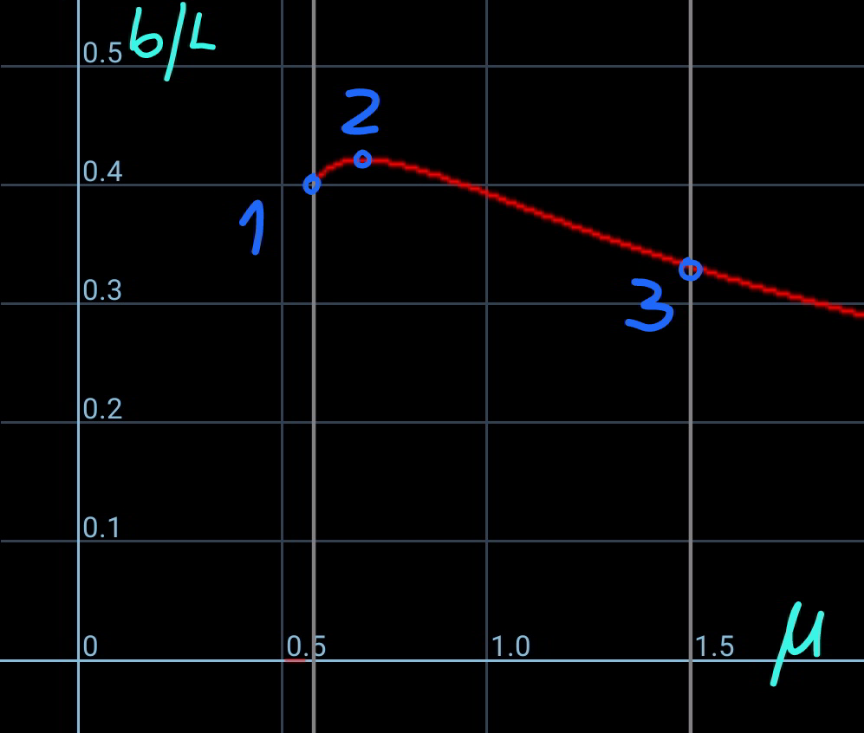
Commented by mr W last updated on 29/May/22
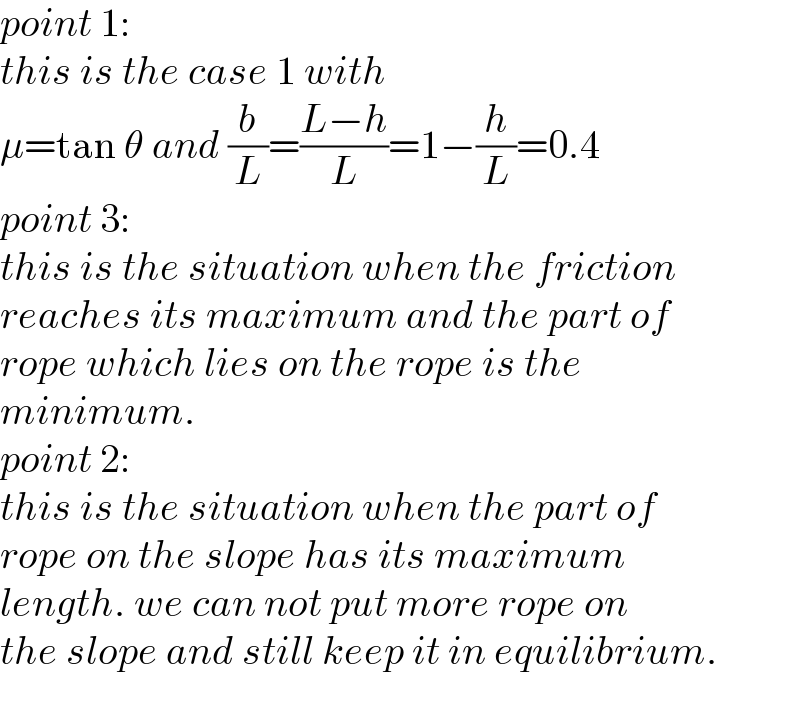
$${point}\:\mathrm{1}:\: \\ $$$${this}\:{is}\:{the}\:{case}\:\mathrm{1}\:{with} \\ $$$$\mu=\mathrm{tan}\:\theta\:{and}\:\frac{{b}}{{L}}=\frac{{L}−{h}}{{L}}=\mathrm{1}−\frac{{h}}{{L}}=\mathrm{0}.\mathrm{4} \\ $$$${point}\:\mathrm{3}:\: \\ $$$${this}\:{is}\:{the}\:{situation}\:{when}\:{the}\:{friction} \\ $$$${reaches}\:{its}\:{maximum}\:{and}\:{the}\:{part}\:{of} \\ $$$${rope}\:{which}\:{lies}\:{on}\:{the}\:{rope}\:{is}\:{the} \\ $$$${minimum}. \\ $$$${point}\:\mathrm{2}: \\ $$$${this}\:{is}\:{the}\:{situation}\:{when}\:{the}\:{part}\:{of} \\ $$$${rope}\:{on}\:{the}\:{slope}\:{has}\:{its}\:{maximum} \\ $$$${length}.\:{we}\:{can}\:{not}\:{put}\:{more}\:{rope}\:{on} \\ $$$${the}\:{slope}\:{and}\:{still}\:{keep}\:{it}\:{in}\:{equilibrium}. \\ $$
Commented by mr W last updated on 29/May/22
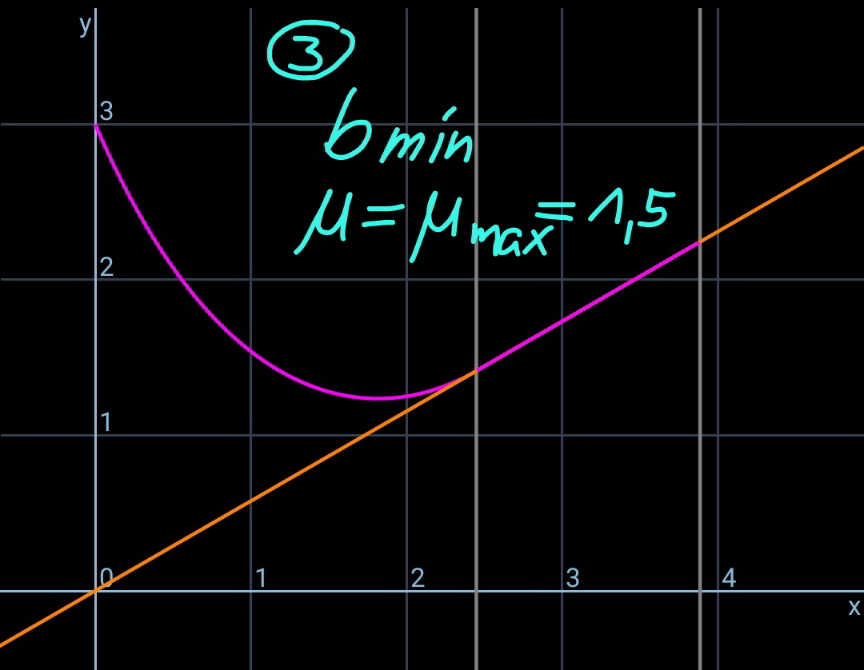
Commented by mr W last updated on 29/May/22
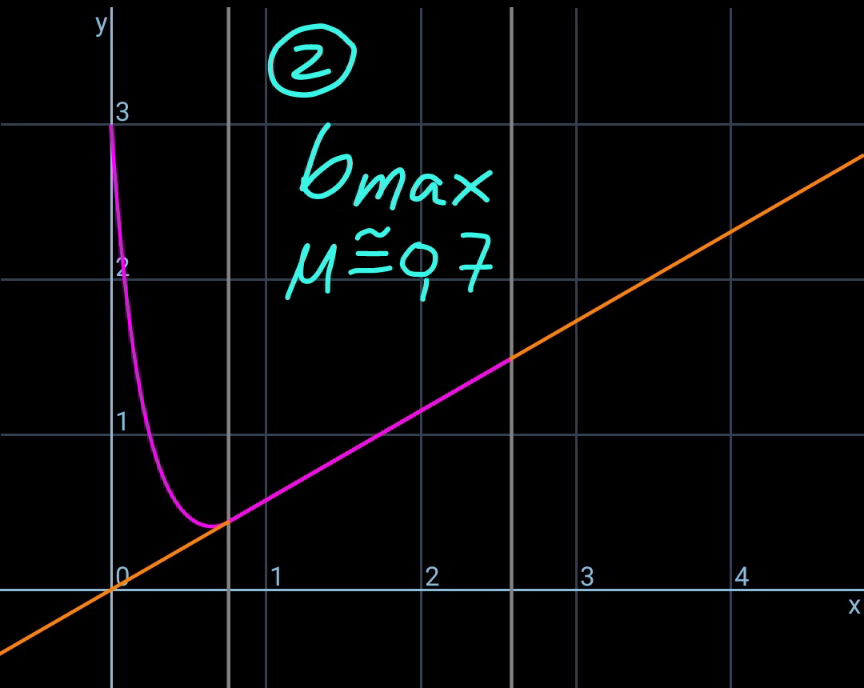
Commented by mr W last updated on 29/May/22
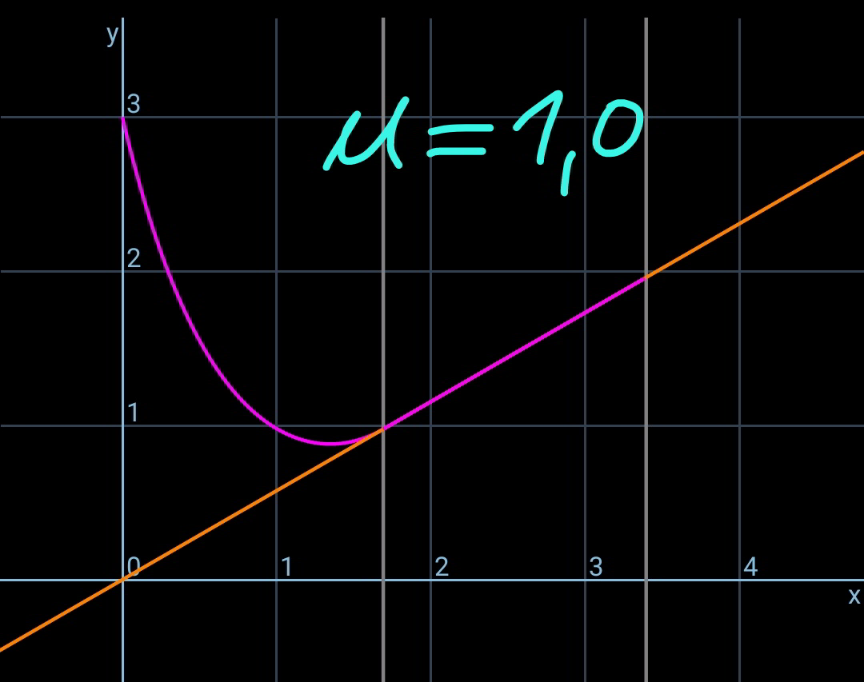
Commented by mr W last updated on 29/May/22
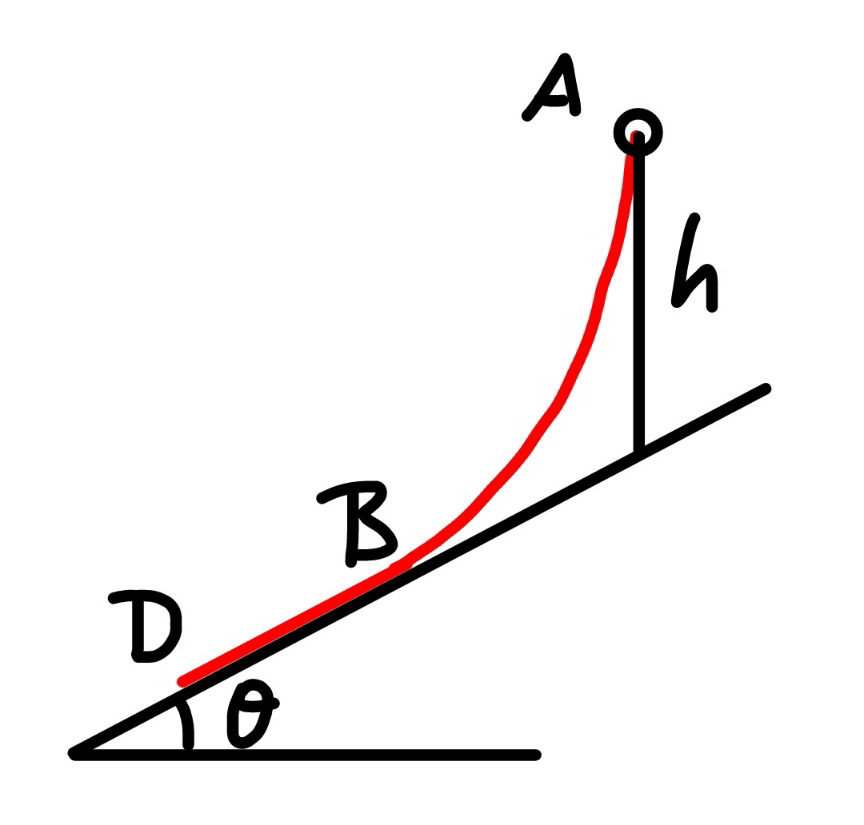
Commented by mr W last updated on 29/May/22

$${case}\:\mathrm{3}:\:\mu<\mathrm{tan}\:\theta \\ $$$${the}\:{friction}\:{force}\:{is}\:{too}\:{small}\:{so}\:{that} \\ $$$${the}\:{hanging}\:{part}\:{of}\:{the}\:{rope}\:{must}\: \\ $$$${hold}\:{the}\:{the}\:{part}\:{lying}\:{on}\:{the}\:{slope}. \\ $$
Commented by mr W last updated on 29/May/22

Commented by mr W last updated on 29/May/22
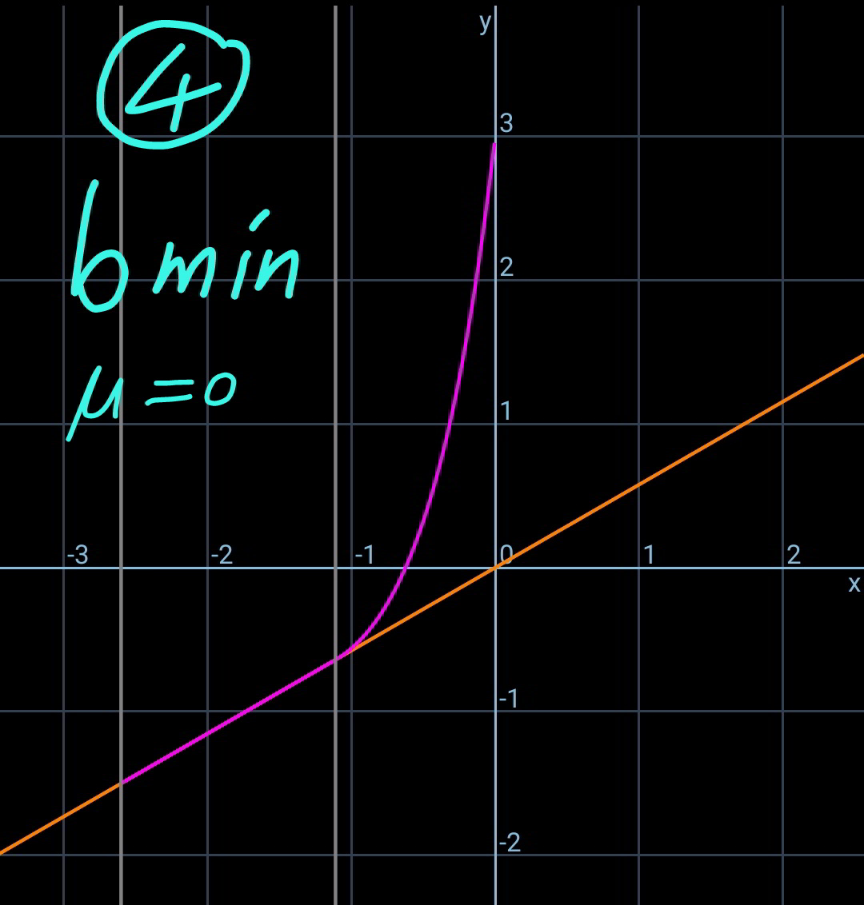
Commented by mr W last updated on 29/May/22
![say the length of the rope part which lies on the inclined plane is b. the friction force between rope and the slope is f. f=μρgb cos θ with 0≤μ<tan θ tension in the rope at point B: T_1 =ρgb sin θ−f=(sin θ−μ cos θ)ρgb let μ′=μ cos θ−sin θ T_1 =−μ′ρgb T_0 =T_1 cos θ=−μ′ρgb cos θ define a=(T_0 /(ρg))=−μ′b cos θ the hanging rope from point A to B is part of a catenary. w.r.t. the coordinate system as shown, y=a cosh (x/a) y′=sinh (x/a) s=a sinh (x/a) tan θ=sinh (x_B /a) ⇒(x_B /a)=sinh^(−1) (tan θ) s_1 =CB^(⌢) =a sinh (x_B /a)=a tan θ AC^(⌢) =L−b+s_1 =a sinh (x_A /a) L−b+a tan θ=a sinh (x_A /a) ⇒(x_A /a)=sinh^(−1) (((L−b)/a)+tan θ) y_A −y_B =h+(x_A −x_B ) tan θ a cosh (x_A /a)−a cosh (x_B /a)=h+(x_A −x_B ) tan θ cosh (x_A /a)−cosh (x_B /a)=(h/a)+((x_A /a)−(x_B /a)) tan θ cosh [sinh^(−1) (((L−b)/a)+tan θ)]−cosh [sinh^(−1) (tan θ)]=(h/a)+[sinh^(−1) (((L−b)/a)+tan θ)−sinh^(−1) (tan θ)] tan θ let (b/L)=(1/λ) cosh [sinh^(−1) (−((λ−1)/(μ′ cos θ))+tan θ)]−cosh [sinh^(−1) (tan θ)]=−((λh)/(μ′L cos θ))+[sinh^(−1) (−((λ−1)/(μ′ cos θ))+tan θ)−sinh^(−1) (tan θ)] tan θ ⇒[sinh^(−1) (((𝛌−1)/(𝛍′ cos 𝛉))−tan 𝛉)+sinh^(−1) (tan 𝛉)]sin 𝛉=1− ((𝛌h)/(𝛍′))−(√(1+(((𝛌−1)/(𝛍′)))^2 −2(((𝛌−1)/(𝛍′)))sin 𝛉)) this equation shows the relationship between λ and the actual friction coefficient μ (0≤μ<tan θ). generally this relationship looks like as shown in the diagram below. example: h=3m, L=5m, θ=30°, μ_(max) =1.5 ⇒(b_(min) /L)=0.22196 at μ=0 (point 4) ⇒(b_(max) /L)=0.43165 at μ=0.7 (point 2)](https://www.tinkutara.com/question/Q170717.png)
$${say}\:{the}\:{length}\:{of}\:{the}\:{rope}\:{part}\:{which} \\ $$$${lies}\:{on}\:{the}\:{inclined}\:{plane}\:{is}\:{b}. \\ $$$${the}\:{friction}\:{force}\:{between}\:{rope}\:{and} \\ $$$${the}\:{slope}\:{is}\:{f}. \\ $$$${f}=\mu\rho{gb}\:\mathrm{cos}\:\theta\:{with}\:\mathrm{0}\leqslant\mu<\mathrm{tan}\:\theta \\ $$$${tension}\:{in}\:{the}\:{rope}\:{at}\:{point}\:{B}: \\ $$$${T}_{\mathrm{1}} =\rho{gb}\:\mathrm{sin}\:\theta−{f}=\left(\mathrm{sin}\:\theta−\mu\:\mathrm{cos}\:\theta\right)\rho{gb} \\ $$$${let}\:\mu'=\mu\:\mathrm{cos}\:\theta−\mathrm{sin}\:\theta \\ $$$${T}_{\mathrm{1}} =−\mu'\rho{gb} \\ $$$${T}_{\mathrm{0}} ={T}_{\mathrm{1}} \:\mathrm{cos}\:\theta=−\mu'\rho{gb}\:\mathrm{cos}\:\theta \\ $$$${define}\:{a}=\frac{{T}_{\mathrm{0}} }{\rho{g}}=−\mu'{b}\:\mathrm{cos}\:\theta \\ $$$${the}\:{hanging}\:{rope}\:{from}\:{point}\:{A}\:{to}\:{B}\: \\ $$$${is}\:{part}\:{of}\:{a}\:{catenary}.\:{w}.{r}.{t}.\:{the} \\ $$$${coordinate}\:{system}\:{as}\:{shown}, \\ $$$${y}={a}\:\mathrm{cosh}\:\frac{{x}}{{a}} \\ $$$${y}'=\mathrm{sinh}\:\frac{{x}}{{a}} \\ $$$${s}={a}\:\mathrm{sinh}\:\frac{{x}}{{a}} \\ $$$$ \\ $$$$\mathrm{tan}\:\theta=\mathrm{sinh}\:\frac{{x}_{{B}} }{{a}}\:\Rightarrow\frac{{x}_{{B}} }{{a}}=\mathrm{sinh}^{−\mathrm{1}} \:\left(\mathrm{tan}\:\theta\right) \\ $$$${s}_{\mathrm{1}} =\overset{\frown} {{CB}}={a}\:\mathrm{sinh}\:\frac{{x}_{{B}} }{{a}}={a}\:\mathrm{tan}\:\theta \\ $$$$\overset{\frown} {{AC}}={L}−{b}+{s}_{\mathrm{1}} ={a}\:\mathrm{sinh}\:\frac{{x}_{{A}} }{{a}} \\ $$$${L}−{b}+{a}\:\mathrm{tan}\:\theta={a}\:\mathrm{sinh}\:\frac{{x}_{{A}} }{{a}} \\ $$$$\Rightarrow\frac{{x}_{{A}} }{{a}}=\mathrm{sinh}^{−\mathrm{1}} \:\left(\frac{{L}−{b}}{{a}}+\mathrm{tan}\:\theta\right) \\ $$$${y}_{{A}} −{y}_{{B}} ={h}+\left({x}_{{A}} −{x}_{{B}} \right)\:\mathrm{tan}\:\theta \\ $$$${a}\:\mathrm{cosh}\:\frac{{x}_{{A}} }{{a}}−{a}\:\mathrm{cosh}\:\frac{{x}_{{B}} }{{a}}={h}+\left({x}_{{A}} −{x}_{{B}} \right)\:\mathrm{tan}\:\theta \\ $$$$\mathrm{cosh}\:\frac{{x}_{{A}} }{{a}}−\mathrm{cosh}\:\frac{{x}_{{B}} }{{a}}=\frac{{h}}{{a}}+\left(\frac{{x}_{{A}} }{{a}}−\frac{{x}_{{B}} }{{a}}\right)\:\mathrm{tan}\:\theta \\ $$$$\mathrm{cosh}\:\left[\mathrm{sinh}^{−\mathrm{1}} \:\left(\frac{{L}−{b}}{{a}}+\mathrm{tan}\:\theta\right)\right]−\mathrm{cosh}\:\left[\mathrm{sinh}^{−\mathrm{1}} \:\left(\mathrm{tan}\:\theta\right)\right]=\frac{{h}}{{a}}+\left[\mathrm{sinh}^{−\mathrm{1}} \:\left(\frac{{L}−{b}}{{a}}+\mathrm{tan}\:\theta\right)−\mathrm{sinh}^{−\mathrm{1}} \:\left(\mathrm{tan}\:\theta\right)\right]\:\mathrm{tan}\:\theta \\ $$$${let}\:\frac{{b}}{{L}}=\frac{\mathrm{1}}{\lambda} \\ $$$$\mathrm{cosh}\:\left[\mathrm{sinh}^{−\mathrm{1}} \:\left(−\frac{\lambda−\mathrm{1}}{\mu'\:\mathrm{cos}\:\theta}+\mathrm{tan}\:\theta\right)\right]−\mathrm{cosh}\:\left[\mathrm{sinh}^{−\mathrm{1}} \:\left(\mathrm{tan}\:\theta\right)\right]=−\frac{\lambda{h}}{\mu'{L}\:\mathrm{cos}\:\theta}+\left[\mathrm{sinh}^{−\mathrm{1}} \:\left(−\frac{\lambda−\mathrm{1}}{\mu'\:\mathrm{cos}\:\theta}+\mathrm{tan}\:\theta\right)−\mathrm{sinh}^{−\mathrm{1}} \:\left(\mathrm{tan}\:\theta\right)\right]\:\mathrm{tan}\:\theta \\ $$$$\Rightarrow\left[\boldsymbol{\mathrm{sinh}}^{−\mathrm{1}} \:\left(\frac{\boldsymbol{\lambda}−\mathrm{1}}{\boldsymbol{\mu}'\:\boldsymbol{\mathrm{cos}}\:\boldsymbol{\theta}}−\boldsymbol{\mathrm{tan}}\:\boldsymbol{\theta}\right)+\boldsymbol{\mathrm{sinh}}^{−\mathrm{1}} \:\left(\boldsymbol{\mathrm{tan}}\:\boldsymbol{\theta}\right)\right]\boldsymbol{\mathrm{sin}}\:\boldsymbol{\theta}=\mathrm{1}−\:\frac{\boldsymbol{\lambda{h}}}{\boldsymbol{\mu}'}−\sqrt{\mathrm{1}+\left(\frac{\boldsymbol{\lambda}−\mathrm{1}}{\boldsymbol{\mu}'}\right)^{\mathrm{2}} −\mathrm{2}\left(\frac{\boldsymbol{\lambda}−\mathrm{1}}{\boldsymbol{\mu}'}\right)\boldsymbol{\mathrm{sin}}\:\boldsymbol{\theta}} \\ $$$${this}\:{equation}\:{shows}\:{the}\:{relationship} \\ $$$${between}\:\lambda\:{and}\:{the}\:{actual}\:{friction} \\ $$$${coefficient}\:\mu\:\left(\mathrm{0}\leqslant\mu<\mathrm{tan}\:\theta\right). \\ $$$${generally}\:{this}\:{relationship}\:{looks}\:{like} \\ $$$${as}\:{shown}\:{in}\:{the}\:{diagram}\:{below}. \\ $$$$ \\ $$$${example}: \\ $$$${h}=\mathrm{3}{m},\:{L}=\mathrm{5}{m},\:\theta=\mathrm{30}°,\:\mu_{{max}} =\mathrm{1}.\mathrm{5} \\ $$$$\Rightarrow\frac{{b}_{{min}} }{{L}}=\mathrm{0}.\mathrm{22196}\:{at}\:\mu=\mathrm{0}\:\left({point}\:\mathrm{4}\right) \\ $$$$\Rightarrow\frac{{b}_{{max}} }{{L}}=\mathrm{0}.\mathrm{43165}\:{at}\:\mu=\mathrm{0}.\mathrm{7}\:\left({point}\:\mathrm{2}\right) \\ $$
Commented by mr W last updated on 30/May/22
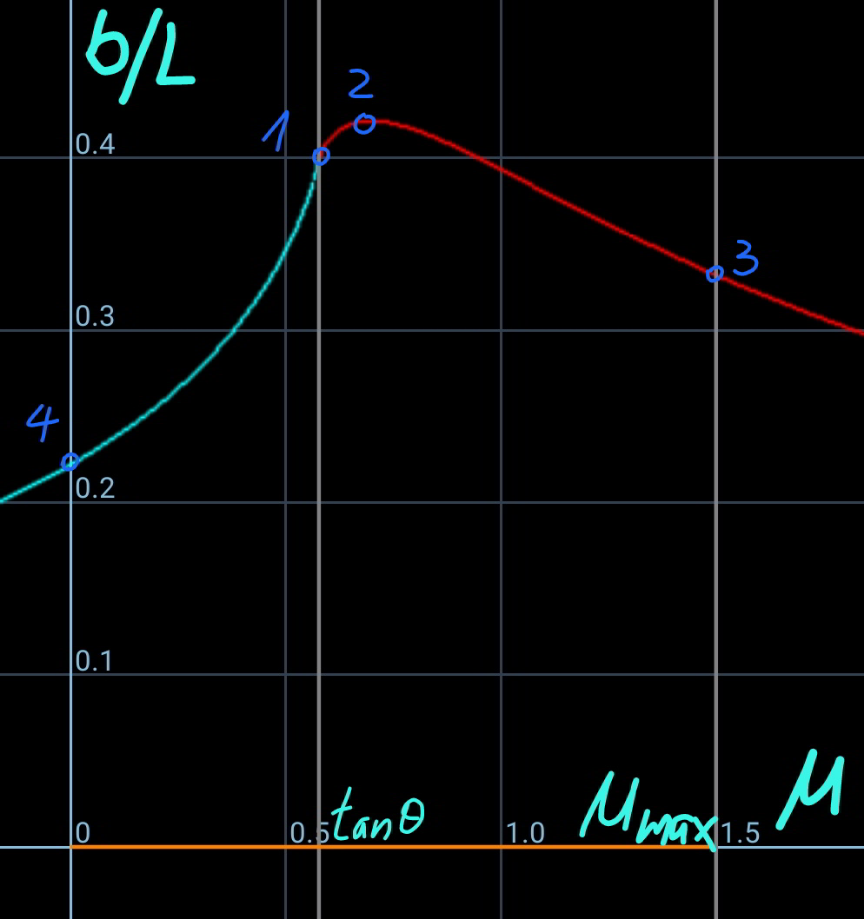
Commented by Tawa11 last updated on 06/Oct/22

$$\mathrm{Great}\:\mathrm{sir} \\ $$
